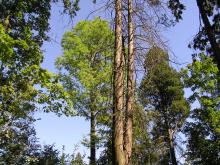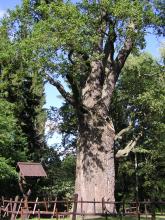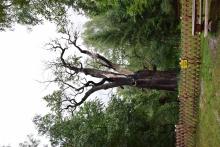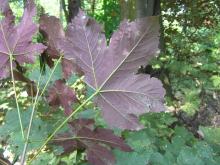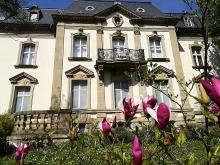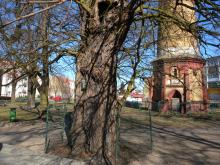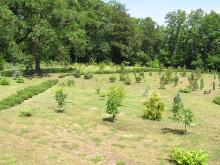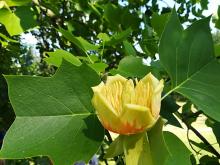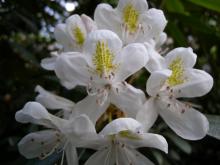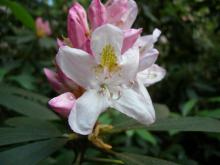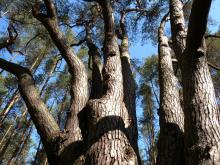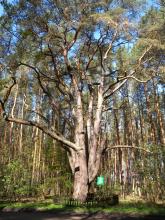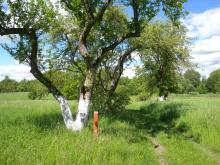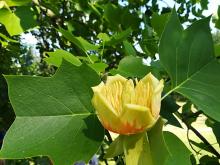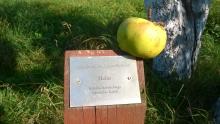Dendrological collections and record-breaking trees and in the Lubusz Voivodeship
Lubusz Voivodeship belongs to those regions of Poland which can be proud of the presence of extremely valuable specimens of dendrofloric. Warm, continental climate in western Poland creates favorable conditions for the occurrence of tree and shrub species, which cannot be seen in such numbers in other parts of the country. These are often visually attractive, beautifully flowering specimens, such as rhododendrons, Lirodendrons or pearl plants. The area of Lubusz Voivodeship is also a place where since the 19th century exotic species of trees were planted in order to check their acclimatization. To this day, many traces of these experiments remain in the form of rare species and varieties.
Lubusz voivodeship is also a place where magnificent specimens of the oldest and thickest trees in the country grow. The most famous of Lubusz’s mature trees are: Poland’s oldest Querkus robur – Chrobry, the thickest pine trees in the country – Rzepicha and Waligóra, the oldest and thickest Ulmus laevis – Wiedźmin, growing in Komorów near Gubin, Morus alba in Sulechów and black locust near Łęgów.
So let’s move on to the presentation:
Chrobry – is the oldest Querkus robur tree in Poland, which unfortunately became famous in the country as a result of information on the November 2014 fire that almost killed the tree. It is a massive tree with a trunk shaped like an elephant’s leg. The circumference of this tree is currently 1007 cm and it is currently the fourth thickest tree in Poland. The age of the tree was determined to be about 750 years and it is a country record when it comes to oaks. The tree grows near the village of Piotrowice on the road from Szprotawa to Przemkowa, on the forest land of the Szprotawa Forest District. Before the first buildings of Piotrowice from the direction of Szprotawa, you have to turn right and further signs show the way to the tree. Before the war the tree was called the Great Oak (German: Grosse Eiche) and was mentioned in all important publications discussing the nature of Lower Silesia.
The so-called papal oaks are related to Chrobry. It is the name of trees planted in various places in Poland, coming from the acorns of Chrobry oak, consecrated by John Paul II, on April 28, 2004, during the pilgrimage of Polish foresters to the Vatican. From 630 seeds it was possible to grow 514 seedlings, which were sent to forest districts, schools and churches all over Poland. Each seedling has a certificate with a number assigned to it.
The oldest and thickest Ulmus laevis in Europe grows in Komorowo (now a district of Gubin) at K. Swierczewskiego Street. The circumference of this tree is 887 cm, and its age is estimated at 450 years. There used to be 3 magnificent branches growing out of the trunk. Inside the tree there is a spacious hollow up to 5 m high. In July 2004, during a huge storm, one of the last two branches broke off. Currently, there is only one bough left and in place of the other two there are decaying hollows.
The thickest Morus alba tree in Europe grows in the centre of Sulechów in a small green area at the junction of Poznańska and 31 Stycznia Streets. The circumference of this tree is 412 cm, it is 18 meters high and 250 years old.
The thickest pine trees in Poland. Rzepicha and Waligóra.
The thickest pine tree in Poland, aptly named "Rzepicha,” grows in the Sulechów Forest District, west of Cigacice. This unusual tree with a circumference of 568 cm grew in the Odra valley, in forest section no. 284. It has many trunks and a wide-spreading crown. Access to it is not easy, due to the Odra River floodplain and the lack of road, and it is mainly enthusiasts who come here. However, it is very easy to reach the second thickest pine tree in Poland – "Waligóra" with an equally impressive circumference of 527 cm. This pine tree also grows within the Sulechów Forest District. This unusual tree has eight spreading branches and was probably created by fusion of several specimens. The pine grows near the road from Sulechów to Poznań, a little bit inside the forest, on the right side of the road.
The thickest black locust in the National Forests near Łęgowo
It grows in the Sulechów Forest District south of Łęgowo. The tree is 507 cm in circumference and 20 m high. A single trunk forks at the height of 4 m. The crown is wide but irregular due to broken and withering branches. In the same forest complex there are also two huge Robinia trees with perimeters of 485 and 373 cm, which are among the ten thickest trees of this species, inventoried in the State Forests. The Robinia appeared on Polish soil around 1800, while the first references to the black locust in the present area of the Lubusz Voivodeship date from 1753, and according to other sources from 1758, from Nietkowo by the Odra River. At that time, according to Prussian sources, a robinia, regarded before the war as the oldest in the then eastern Germany, was supposed to have been planted in the park in Nietkowo by Frederick Wielki. Nowadays this tree does not exist.
The oldest Pterocarya fraxinifolia in Poland with the height of 26 m and the circumference of 434 cm grows in the center of Szprotawa in the green area at T. Kościuszki Street. The age of the tree was estimated at 230 years.
Napoleon Oak
At this point, it is also worth mentioning Napoleon, which was the thickest oak tree in Poland. Until 2010, it grew on the edge of the Odra valley, east of Zabór. It had an impressive circumference of 1052 cm and a huge hollow inside its trunk. Its age was estimated at over 600 years. It was consumed by fire several times, but each time it regenerated its crown and continued to stand. Unfortunately, the last fire in November 2010 killed the tree. Today, its descendant grows in the place of the former colossus. Before the war, the oak bore the name of the Silesian nature researcher – Teodor Schube. At the naming in 1920, Princess Hermina von Reuss, later wife of German Emperor Wilhelm II, was present. After the war, the oak received a new name – Napoleon.
The most beautiful dendrological collections
Places where interesting tree and shrub species are collected are called arboretums, dendrological gardens or dendrological collections. The name arboretum comes from the Latin word arbor – meaning tree. Many dendrological collections in Lubusz Voivodeship are the objects of State Forests and former parks around historical residences.
Collection of pines in the Wysokie Lakes
A dendrological collection is being created on a nearly 2-hectare area at the Natural Forest Education Center in Wysokie Lakes near Lubsko, where the main goal is to gather as many different species of pines as possible. Currently, the collection contains 33 species and varieties from different parts of the world. Interesting species of trees and shrubs from different parts of the world also grow here. The most interesting of them are e.g. Liriodendron tulipifera, Cryptomeria, Ginkgo biloba, Sequoiadendron giganteum, various species of cedars, firs, spruces, cypresses and magnolias, as well as old chestnut trees bearing fruit.
The floral garden at Nowym Młyn
In the Rzepin Forest District, at Nowy Młyn forester’s lodge, there is a floristic garden which was created in 2004 on the initiative of the forester Mirosław Kucza.
In the garden with an area of 5 hectares, near the flowing Ilanka River, you can admire more than 2000 species and varieties of plants. Trees, shrubs, bushes and herbaceous plants, both domestic and foreign, coming from different regions of the world, are gathered here. There are collections of firs, spruces, pines and junipers. Further along the Ilanka River there is a charming path called "The Beaver Trail,” 3.5 km long. On the route there are: wigwam, bird shelter, beaver dam and natural monument – the oak "Piast" with an impressive circumference of 630 cm and a beautiful wide crown.
Arboretum in the Valley of Three Mills in Bogdaniec
Near Gorzów, at the seat of the Bogdaniec Forest District, there is "Arboretum in the Valley of Three Mills.” Along the educational path, there are more than 50 species of forest trees and shrubs growing in the Polish forests.
Nietków. Historic arboretum with Mużakowski oak tree
On the grounds of the Zielona Góra Forest District, near Nietkowo, among old riverine forests, in the Odra valley, there are remains of an interesting arboretum. This collection of woody plants was founded by the von Rothenburg family from nearby Czerwieńsk in 1893-1895. A "Grove of conifers" was created in the oak forest where over 150 different species and varieties were planted. After the Second World War, the arboretum was incorporated into the State Forests. After a flood in 1997, which destroyed a considerable part of the collection, 71 taxons remained. The most interesting oaks include Caucasian, Quercus cerris, tanner’s, chestnut-leaved as well as mottle-leaved and sessile varieties. There are also interesting varieties of lindens and maples, including the Devil’s Maple. Particularly noteworthy is the Mużakowski oak, the leaves of which resemble laurel leaves. The Arboretum in Nietków is slowly regaining its former glory, thanks to the project of revitalization of historical parks in Czerwieńsk community.
Iłowa – grove of rhododendrons
In the park established by Count Hochberg in Iłowa there is an interesting collection of rhododendrons, and mainly grand rhododendrons, forming a real grove by the Czerna Wielka River. Professor Czekalski identified seven colour varieties here.
The basic material for the collection of rhododendrons in what is now south-west Poland was most often supplied by the famous Seidl nurseries (still in existence today), located in Grüngräbchen near Drezno. The nurseries were established in the mid-19th century and introduced new varieties and cultivars of the so-called Lusatian breed (based mainly on the Catawba rhododendron). At the beginning of the 20th century there was a trend for rhododendron collections, as exemplified by Wojsławice, Iłowa, Moszna, Polanica-Zdrój, Książ Castle, Szczawno-Zdrój and Bad Muskau, located near the border, with its Pückler Park, listed by UNESCO, and Kromlau, 8 km from Łęknica, with its magnificent rhododendron valley and basalt bridge.
It is worth thinking about planning a "rhododendron" trip to these places in late May and early June.
GORZÓW
Among dendrological curiosities of Gorzów, the dendrological garden by the Jan Dekert Lubuski Museum in Gorzów Wielkopolski deserves special attention. In the historic park, surrounding the eclectic Schroeder villa from the beginning of the 20th century, on the area of 3.32 ha, over 150 species and varieties of trees and shrubs grow, including magnolias, well-known to all Gorzów residents, blooming in early spring in front of the museum building.
ZIELONA GÓRA
Since 1956 one of the most recognizable symbols of the city is the palm house, towering over the city on the top of Winne Hill. It houses 200 species of plants, including 120 tropical ones. Among the greenery there is a restaurant and a cafe on the first floor, from which you can admire the city panorama.
An interesting trail of natural monuments leads through the city centre, presenting many exotic tree specimens, e.g. Quercus frainetto, plane trees, ginkgoes, catalpa trees and Japanese pearls. In 2007, the Botanical Garden of Zielona Góra University was opened in the city. Almost 500 species and varieties of plants were planted on an area of 2.5 ha. A minizoo was created next to it.
Finally, it is worth mentioning an unusual dendrological collection, namely Mużakowski Nurseries in Mużakowski Park in Łęknica. There is a collection of old varieties of apple trees with such charming names as Kuzynek Buraczek, Pepina Parker, Kalwilla Adersleberga or Piękna z Herrnhut. A pomological trail has been laid out among the centuries-old apple trees, where 40 old varieties. In autumn, you can taste apples with great taste and aroma.
elaborated by Marek Maciantowicz
Localization:
The public task is co-financed from the funds received from the Marshal's Office of the Lubuskie Voivodeship



